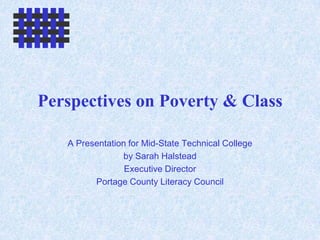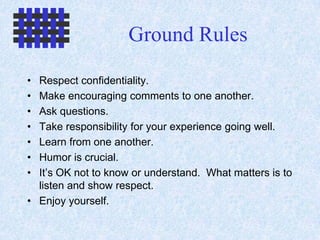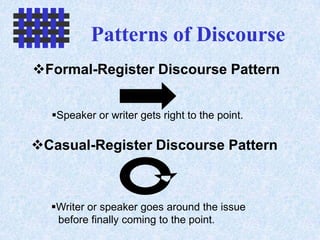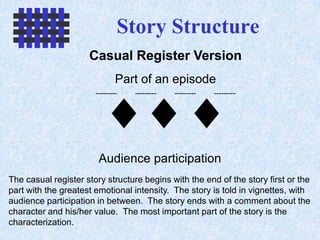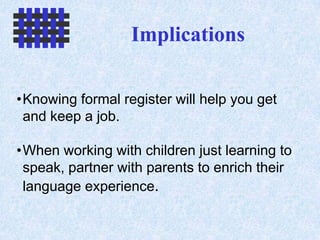Perspectives on Poverty and Class
- 1. Perspectives on Poverty & ClassA Presentation for Mid-State Technical Collegeby Sarah HalsteadExecutive DirectorPortage County Literacy Council
- 2. ….a “Reader’s Digest” version…
- 3. In the next two hours, we will:Examine ways in which our own cultural values, beliefs and experiences influence our thinking and decision-making.Recognize opportunities as they relate to social class, class privilege and family circumstances.Engage in building positive relationships with people across class lines.Understand differences in language and communication for socio-economic groups.Identify a goal for using information learned.
- 4. Ground RulesRespect confidentiality.Make encouraging comments to one another.Ask questions.Take responsibility for your experience going well.Learn from one another.Humor is crucial.It’s OK not to know or understand. What matters is to listen and show respect.Enjoy yourself.
- 5. Assumption:What we believe about what we seeOne Way More than one way Many WaysTogether create a way that fits this situationMy WayYour way is different than mineThere is a way that fits this situationOne way is the bestDeveloped by Barb Roder, UWEX Family Living from Working with Differences in Communities
- 8. Patterns of DiscourseFormal-Register Discourse Pattern
- 9. Speaker or writer gets right to the point.
- 11. Writer or speaker goes around the issue before finally coming to the point.
- 12. Story StructureFormal Register VersionPlotBEThe formal register story structure starts at the beginning of the story and goes to the end in a chronological or accepted narrative pattern. The most important part of the story is the plot.
- 13. Story StructureCasual Register VersionPart of an episode--------- --------- --------- ---------Audience participationThe casual register story structure begins with the end of the story first or the part with the greatest emotional intensity. The story is told in vignettes, with audience participation in between. The story ends with a comment about the character and his/her value. The most important part of the story is the characterization.
- 14. ImplicationsFormal register needs to be directly taught
- 15. Casual register needs to be recognized as the primary discourse for many
- 16. Both story structures need to be a part of instructionImplicationsKnowing formal register will help you get and keep a job.
- 17. When working with children just learning to speak, partner with parents to enrich their language experience.Skills for Communicating With Those Who Use Casual Register and Circular Story StructuresDraw the story as it is told, using symbols and making brief notes on dates, ages, etc.
- 18. Straighten into linear report later
- 19. Help participants learn to express displeasure in formal register
- 20. Expect participation in the writing and telling of stories
- 21. Use stories to educate and to process experiencesReflect and Share:Something you will try to do differently?Something you will share with someone?Something you want to explore further?An AHA! You experienced?
- 22. Thank You!! I hope you found this presentation helpful. If you’d like more information on this topic please feel free to contact me. Sarah Halstead Executive DirectorPortage County Literacy Council1052 Main Street, Ste. 104 Stevens Point, WI 54481 Phone: 715-345-5341 email: pclc@pocolit.org or creativememorieslady@msn.com

